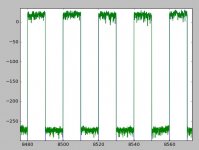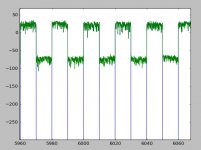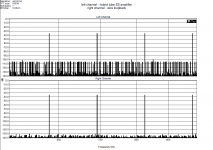properly sum stereo to mono
Hi, congratulations on your build, it looks very impressive.
I suggest you listen to one channel at a time instead of summing to mono. Much more interesting, and usually sounds much better. Even with minimalistic acoustic recordings. (Make a switchbox... You can decide which "perspective" of the band / ensemble is more enjoyable to you 🙂 )
-Alex
If I may interject a technical post here, I hope folks will indulge me. We discussed noise floor modulation with respect to very subtle DAC differences. I suggested an extension to the multitone test which comprised a selection of real music with regular portions of the spectrum removed so that one can observe the empty spaces being filled by non-idealities in the system transfer function.
I took 30sec from the first track of "The Final Cut" by PF and removed via FFT filtering 10Hz bands at 20Hz spacings. The result is still recognizable as the music (via listening) but very strange. The pictures here are the filtered data and original data filtered showing the noise floor of double precision FP. The second plot is adding a 0.01% second harmonic distortion giving the theoretical -100dB noise floor. I think the key here is that simple distortions in the signal path now appear as a modulation of the noise floor.
Disclaimer - This is something I just did as an experiment I make no claims of it having any rigid scientifically valid applicability.
EDIT - The entire cut is filtered by an FFT of the entire length, so yes Virginia you can do absolute brickwall filters without any windowing, etc.
I took 30sec from the first track of "The Final Cut" by PF and removed via FFT filtering 10Hz bands at 20Hz spacings. The result is still recognizable as the music (via listening) but very strange. The pictures here are the filtered data and original data filtered showing the noise floor of double precision FP. The second plot is adding a 0.01% second harmonic distortion giving the theoretical -100dB noise floor. I think the key here is that simple distortions in the signal path now appear as a modulation of the noise floor.
Disclaimer - This is something I just did as an experiment I make no claims of it having any rigid scientifically valid applicability.
EDIT - The entire cut is filtered by an FFT of the entire length, so yes Virginia you can do absolute brickwall filters without any windowing, etc.
Attachments
Last edited:
Hi, congratulations on your build, it looks very impressive.
I suggest you listen to one channel at a time instead of summing to mono. Much more interesting, and usually sounds much better. Even with minimalistic acoustic recordings. (Make a switchbox... You can decide which "perspective" of the band / ensemble is more enjoyable to you 🙂 )
-Alex
Ha ha, I hadn't really thought about it. I've got an ABY guitar switching pedal I can hook in and give it a go. Thank you for that.
I took 30sec from the first track of "The Final Cut" by PF and removed via FFT filtering 10Hz bands at 20Hz spacings. The result is still recognizable as the music (via listening) but very strange. The pictures here are the filtered data and original data filtered showing the noise floor of double precision FP. The second plot is adding a 0.01% second harmonic distortion giving the theoretical -100dB noise floor. I think the key here is that simple distortions in the signal path now appear as a modulation of the noise floor.
Disclaimer - This is something I just did as an experiment I make no claims of it having any rigid scientifically valid applicability.
EDIT - The entire cut is filtered by an FFT of the entire length, so yes Virginia you can do absolute brickwall filters without any windowing, etc.
How did you do it? Which tools? And which FFT to see the results?
I would imagine that the music would be mostly recognizable with some weird qualities to it. Our hearing processes are very robust for getting content from noise.
How did you do it? Which tools? And which FFT to see the results?
I would imagine that the music would be mostly recognizable with some weird qualities to it. Our hearing processes are very robust for getting content from noise.
Python and numpy no stupid power of two FFT restrictions. I just did a real FFT of the whole 30 sec (1440000 samples) and removed bins and did the inverse FFT.
Ha ha, I hadn't really thought about it. I've got an ABY guitar switching pedal I can hook in and give it a go. Thank you for that.
When you sum a stereo recording that has bass you will get into trouble. The wavelengths are long and mikes that are spaced will have significant phase differences. Summing for subwoofers is not a good idea. It was more successful in the vinyl era because the record was already processed (and the quality of the bass suffered). There were boxes that could modulate the phase to minimize the problem (used for broadcasting to ensure those listening to mono did not wander to a different station). In the digital era a lot of those tricks have been lost. I always cringe when people sum bass for a subwoofer. If you have one sub pick a channel, it doesn't matter much which channel. On acoustically recorded music in real spaces the differences are clear between summed bass and even one channel bass.
For a mono setting for a phono cartridge put the two channels in series. The difference will cancel and the sum (what you want) will be stronger than simply paralleled, always good with a low level transducer.
.......... I think the key here is that simple distortions in the signal path now appear as a modulation of the noise floor.
Thanks for this. If I understand correctly, the 2nd FFT showing grass at ~ -75dB rather than -100dB that it should be, theoretically shows 25dB rise as a result of NFM?
Last edited:
If I may interject a technical post here
Thanks Scott.
Very interesting and intriguing!
Questions:
1.The 30s file was a recording from vinyl rip?
2. What you show is:
The first screenshot is from the original content and the second is from the one with the added distortion?
Now a friendly suggestion
Either you make a step by step article for real dummies and no hackers or you will be flooded by e-mails with attachment of test samples for you to analyze and post results. You don't want that, do you? 😀
Yes, true. Thanks DemianOn acoustically recorded music in real spaces the differences are clear between summed bass and even one channel bass.
For a mono setting for a phono cartridge put the two channels in series. The difference will cancel and the sum (what you want) will be stronger than simply paralleled, always good with a low level transducer.
Two points:
Extra care for RIAA pre overloading.
Some problems with loading and HF roll-off.
How connect stereo cartridge to mono riaa ?
George
Yes I just created a simple distortion profile to show the expected result.Thanks for this. If I understand correctly, the 2nd FFT showing grass at ~ -75dB rather than -100dB that it should be, theoretically shows 25dB rise as a result of NFM?
Thanks Scott.
Very interesting and intriguing!
Questions:
1.The 30s file was a recording from vinyl rip?
2. What you show is:
The first screenshot is from the original content and the second is from the one with the added distortion?
Yes
Thanks Scott.
Very interesting and intriguing!
Questions:
1.The 30s file was a recording from vinyl rip?
2. What you show is:
The first screenshot is from the original content and the second is from the one with the added distortion?
-------------------------------
Now a friendly suggestion
Either you make a step by step article for real dummies and no hackers or you will be flooded by e-mails with attachment of test samples for you to analyze and post results. You don't want that, do you? 😀
and how would you reduce this affect??
-RNM
Last edited:
Two points:
Extra care for RIAA pre overloading.
Some problems with loading and HF roll-off.
How connect stereo cartridge to mono riaa ?
George
It took me quite a while to get my head around why series connection was theoretically better and arguments rage on the internet over it regularly.
For non-vinyl of course simple summing gives +6dB boost to centre information. Studer (and I assume others) did mono modules with a 90 degree phase shift in to de-correlate the centre channel. I assume that is what Demian was talking about?
When you sum a stereo recording that has bass you will get into trouble. The wavelengths are long and mikes that are spaced will have significant phase differences. Summing for subwoofers is not a good idea. It was more successful in the vinyl era because the record was already processed (and the quality of the bass suffered). There were boxes that could modulate the phase to minimize the problem (used for broadcasting to ensure those listening to mono did not wander to a different station). In the digital era a lot of those tricks have been lost. I always cringe when people sum bass for a subwoofer. If you have one sub pick a channel, it doesn't matter much which channel. On acoustically recorded music in real spaces the differences are clear between summed bass and even one channel bass.
There were/are phase rotator boxes to ensure symmetrical peak modulation, essential for AM.
Recording/Tracking 101.....Mono Compatibility: Avoid Humiliation!
Mono combatability is mandatory....mono kitchen radios , mono BGM, mono mobile phones, mono BT speakers........
Dan.
It took me quite a while to get my head around why series connection was theoretically better and arguments rage on the internet over it regularly.
These are practical issues depending on the particular cartridge and preamplifier combination one has to deal with. Test first.
Initially plug two “Y” RCA splitters at the end of the arm interconnect cable and do the series and parallel connections there (*) for not to mess with the cartridge pins.
Do overload and FR tests using a test record. After evaluating the test recordings proceed with music listening (adjust for the level change btn series/parallel connection)
(*) you may need two more “Y” splitters for loading adjustment.
Recording/Tracking 101
Dan, that was a good article. Thanks.
George
Vinyl rip?
Can you do the same thing for the red-book version and same excerpt? 🙂
If this method holds water I think this may be the key to progressing digital audio to the level promised as I believe that music correlated noise tails are a (the) real party pooper. If it becomes measurable, it will be mitigated. So the hero is the measurement inventor.
If would love to be able to do it myself so I second the request for a cook-book recipe.
A wonderful contribution - thanks!!
//
Can you do the same thing for the red-book version and same excerpt? 🙂
If this method holds water I think this may be the key to progressing digital audio to the level promised as I believe that music correlated noise tails are a (the) real party pooper. If it becomes measurable, it will be mitigated. So the hero is the measurement inventor.
If would love to be able to do it myself so I second the request for a cook-book recipe.
A wonderful contribution - thanks!!
//
If I may interject a technical post here, I hope folks will indulge me. We discussed noise floor modulation with respect to very subtle DAC differences. I suggested an extension to the multitone test which comprised a selection of real music with regular portions of the spectrum removed so that one can observe the empty spaces being filled by non-idealities in the system transfer function.
I took 30sec from the first track of "The Final Cut" by PF and removed via FFT filtering 10Hz bands at 20Hz spacings. The result is still recognizable as the music (via listening) but very strange. The pictures here are the filtered data and original data filtered showing the noise floor of double precision FP. The second plot is adding a 0.01% second harmonic distortion giving the theoretical -100dB noise floor. I think the key here is that simple distortions in the signal path now appear as a modulation of the noise floor.
Disclaimer - This is something I just did as an experiment I make no claims of it having any rigid scientifically valid applicability.
EDIT - The entire cut is filtered by an FFT of the entire length, so yes Virginia you can do absolute brickwall filters without any windowing, etc.
If I may interject a technical post here, I hope folks will indulge me. We discussed noise floor modulation with respect to very subtle DAC differences. I suggested an extension to the multitone test which comprised a selection of real music with regular portions of the spectrum removed so that one can observe the empty spaces being filled by non-idealities in the system transfer function.
We can see apparent (apparent because it is a visual effect of many intermodulation lines) noise floor elevation or "modulation" in a multitone test as well, in case that distortion is high enough. Still, it does not seem to make an audible difference.
Can you tell original file from tube amp record? - test
Attachments
PMA - maybe the distorsion you add in your last test is not the worst kind. I'm thinking of one that is (maybe) generated by D/A converters - or A/D.
//
//
PMA - maybe the distorsion you add in your last test is not the worst kind. I'm thinking of one that is (maybe) generated by D/A converters - or A/D.
//
I understand what you mean, but please take into account that we speak about -40dBFS vs. something like -110dBFS (or even less). And the DAC/ADC "distortion" is included in the tube file distortion, which is being compared to the original file (original rip).
When you sum a stereo recording that has bass you will get into trouble. The wavelengths are long and mikes that are spaced will have significant phase differences. Summing for subwoofers is not a good idea. It was more successful in the vinyl era because the record was already processed (and the quality of the bass suffered). There were boxes that could modulate the phase to minimize the problem (used for broadcasting to ensure those listening to mono did not wander to a different station). In the digital era a lot of those tricks have been lost. I always cringe when people sum bass for a subwoofer. If you have one sub pick a channel, it doesn't matter much which channel. On acoustically recorded music in real spaces the differences are clear between summed bass and even one channel bass.
Good point... "Bass is not directional" does not imply bass L and R can be summed, if recorded as stereo. Most commercial subwoofers are sold for use as a single unit with 2 inputs L and R, I wonder what they do internally?
For the fun of it, yesterday on a german forum I posted a similar listening test like yours, using the original file vs this file recorded three times in a row through a RME Adi-2 Pro in loopback, with the cheapest RCA cables I could find. I'll most likely post it here, too (just trying to gather some experiences first).I understand what you mean, but please take into account that we speak about -40dBFS vs. something like -110dBFS (or even less). And the DAC/ADC "distortion" is included in the tube file distortion, which is being compared to the original file (original rip).
- Status
- Not open for further replies.
- Home
- Member Areas
- The Lounge
- John Curl's Blowtorch preamplifier part III



